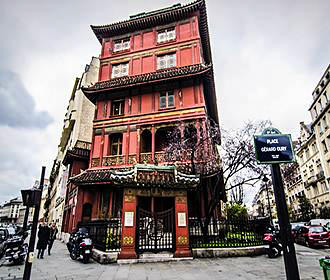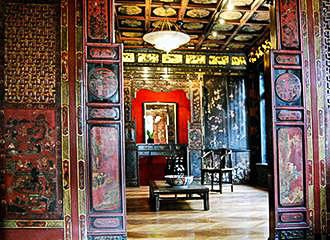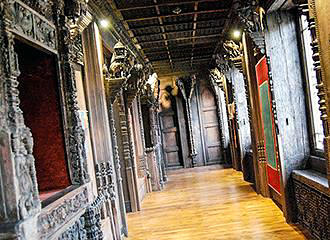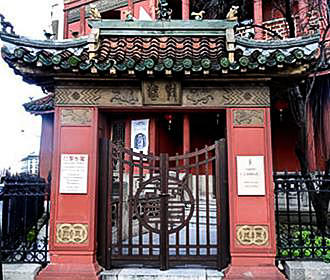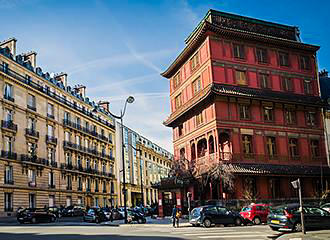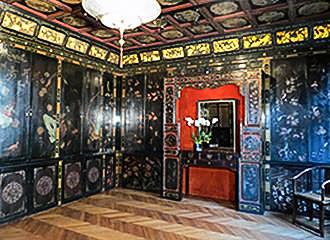The Paris Chinese Pagoda building
If ever you thought there were some unusual buildings and Paris monuments, then the Paris Chinese Pagoda building has got to be one not to be missed, with its landmark exterior and its sumptuous interior.
Paris Chinese Pagoda history
The building was originally constructed as a standard mansion house in the French Louis Philippe style, however, it was purchased in 1925 by Ching Tsai Loo, who was a collector and dealer of Chinese and Asian antiques.
He decided to transform the house into a Chinese Pagoda to showcase his exquisite collection of art and antiques that Ching Tsai Loo had collected over many years.
So with the help of an architect by the name of Fernand Bloch, and under careful supervision and direction of Ching Tsai Loo himself, the building was completely transformed on the exterior to represent an authentic Chinese Pagoda, with its typical red colours and architectural features.
The interior was also completely transformed into what was more like a sumptuous Chinese palace with Shanxi lacquer panels, wood panelling and other specifically themed rooms, like the Petit Salon Porcelaine.
The Heritage of Ching Tsai Loo and the Paris Chinese Pagoda
Ching Tsai Loo was a business man who was very influential in helping to introduce Asian culture into the west, establishing two of the most important galleries for Asian art in Paris, France and in New York, USA.
Having a quest for knowledge throughout his lifetime, he amassed a vast collection of over 1,300 books and around 3,000 catalogues from different exhibitions and auctions that had been conducted worldwide.
Along with over 3,000 original photographs of art works and his personal correspondence with dealers, collectors and museums, the fascinating archives were purchased in conjunction with the Pagoda in Paris, so as to serve as a resource for art specialists, collectors, museums and international auction houses.
The Paris Chinese Pagoda Building Today
The Paris Chinese Pagoda building has been fully restored to its former glory with its impressive 17th and 18th century Chinese wood panelling, along with many other original architectural features and Asian details of this unusual Paris tourist attraction.
The art works and the building have been preserved and protected, which makes it the perfect place for events where privatisation for receptions, banquets, auctions and much more can be organised. Yet this is also a meeting point for cultural exchanges and a communication link between the Eastern and Western worlds.
The Galerie Pagoda Paris was also established in 2012 in order to host important exhibitions and for sales of Chinese and Asian art works, which was built upon the legacy of Ching Tsai Loo, who also had a gallery housed here for approximately 50 years.
This was to represent both new and emerging art talents along with those that are already established with their roots in China and the Asia Pacific, and hence temporary exhibitions are held for the public from time to time.
Visiting to the Paris Chinese Pagoda building
This unusual building that is now classified as a historical Paris monument but is not open to visitors all the time, except for when there are temporary exhibitions, and to give you an idea, the last exhibition, which could be accessed from a Wednesday through to a Saturday was a cost of €10 per person.
You will find the Paris Chinese Pagoda building within the 8th Arrondissement close to the Parc Monceau in one direction, the Musee Jacquemart-Andre museum in the opposite direction and the Salle Pleyel concert hall in another.
Even if it is not open for a visit, this unique and very unusual Paris landmark is still well worth seeing on the outside, especially now it has been fully restored to its former glory.
Access to the Paris Chinese Pagoda building
When it comes to getting here via Paris public transport you will find that the nearest metro station is the Courcelles stop serving line 2, or alternatively, in the opposite direction you have the Saint-Philippe-du-Roule stop serving line 9.
Alternatively, the Paris bus lines 22, 28, 30, 31, 32, 43, 52, 80, 83, 84, 93 and 341 along with the Noctilien Night Bus Service via line N53 will all get you within walking distance of the Pagoda Paris and numerous other tourist attractions in the area, including even the famous Arc de Triomphe.
